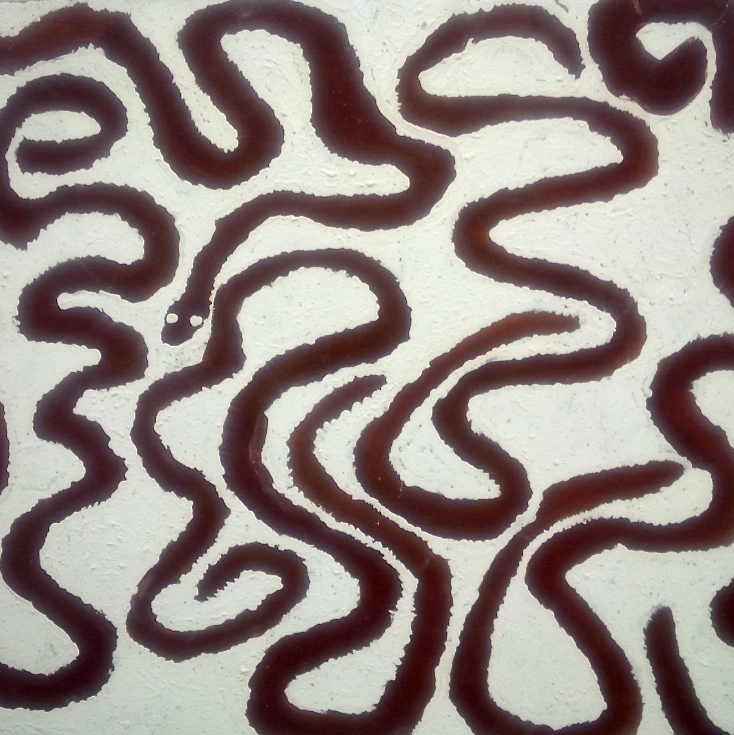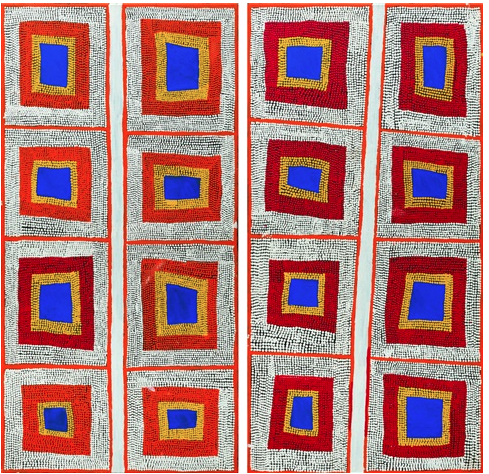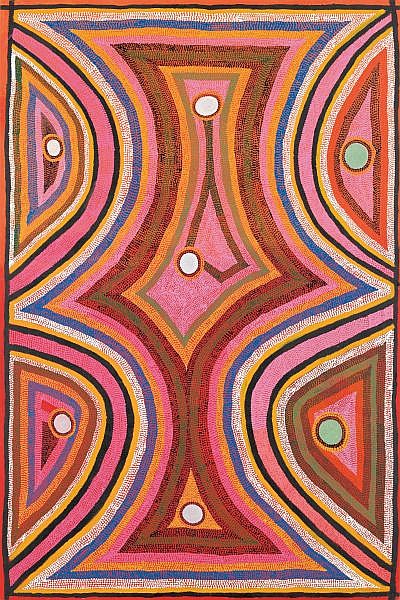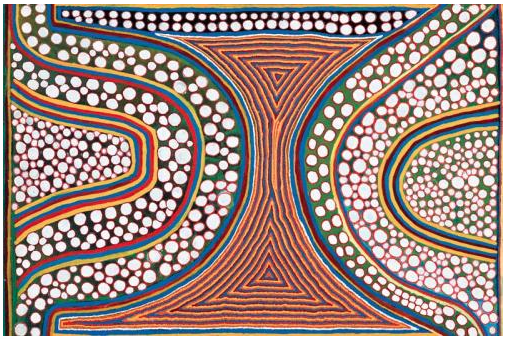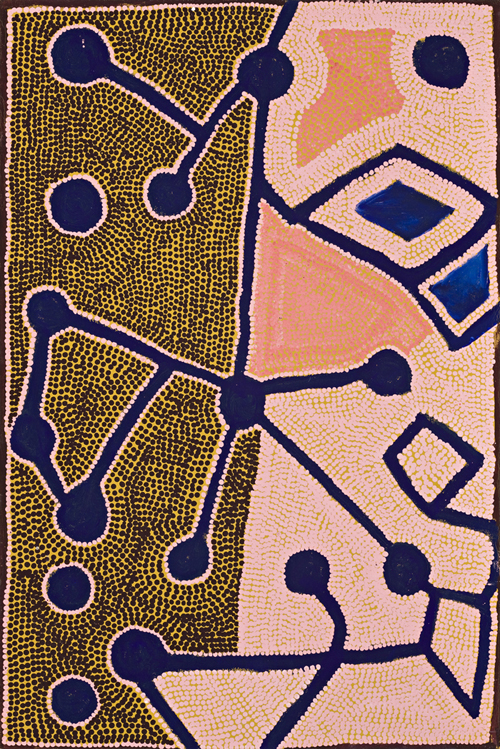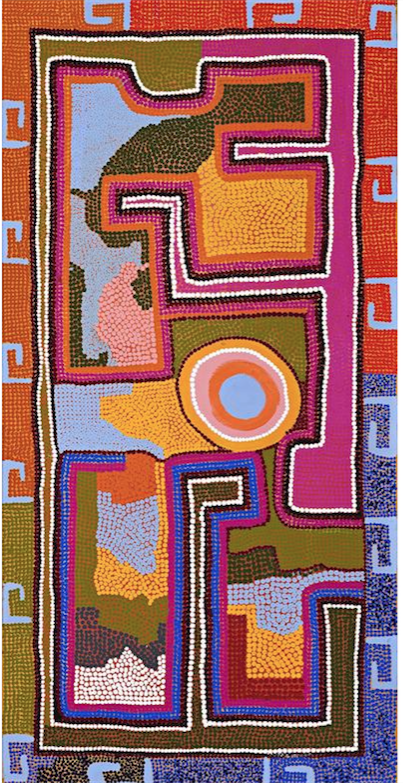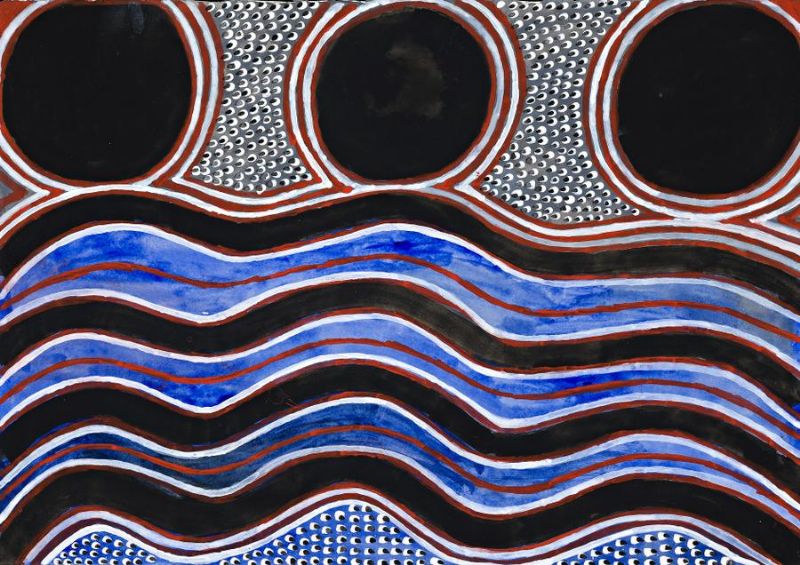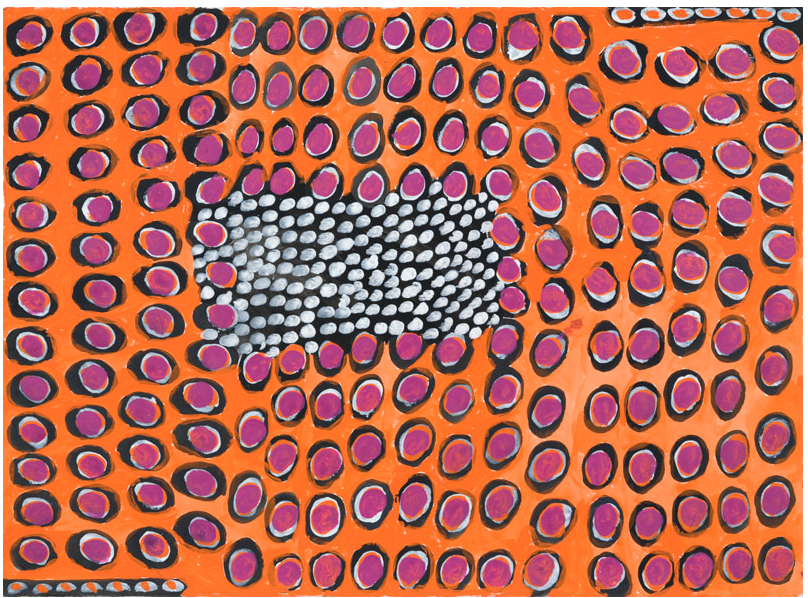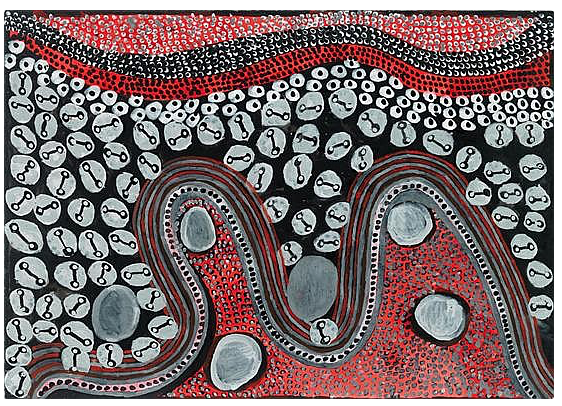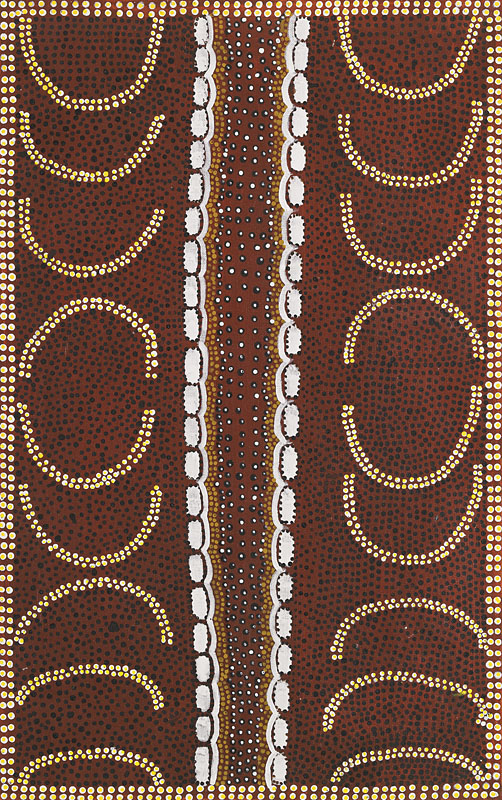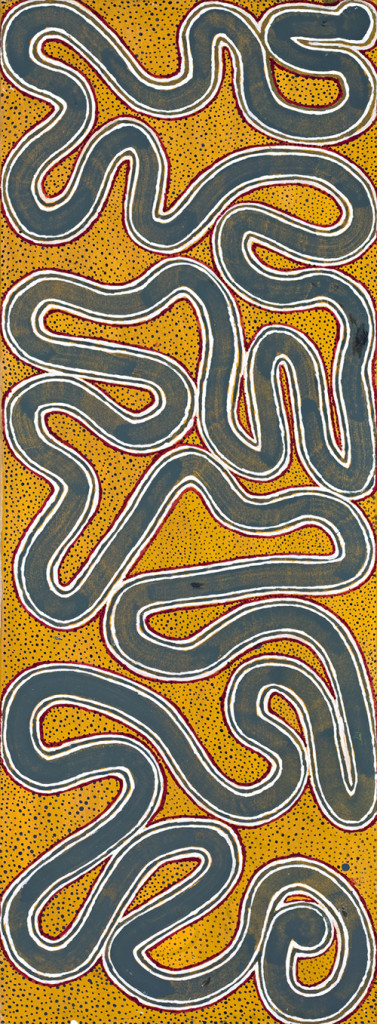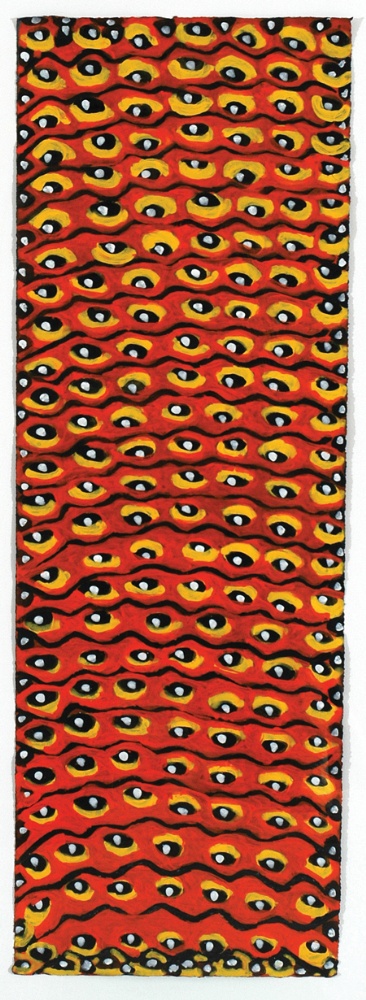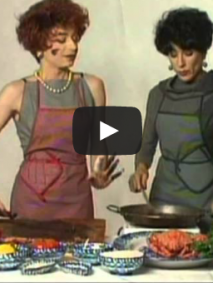No Boundaries from the Australian desert painters.
I recently saw an extraordinary show at the Perez Art Museum in Miami ( PAMM) : No Boundaries: Aboriginal Australian Contemporary Abstract Painting I have just read that this show will tour the USA extensively and I really advice you to catch it on its tour.
For me it’s about ancient language, symbols and signs that have connected continents and civilizations over 40.000 years. Aboriginal art makes me think of the Paleolithic and Neolithic drawings found in the caves of Altamira in Spain and how the artistic representations of prehistoric men in Europe transcend and become a universal language, depictions of which I saw in this modern show.
Above : Ngurra Yalyalji and Malngirri 2006. Image courtesy PAMM.
“No Boundaries: Aboriginal Australian Contemporary Abstract Painting brings together the work of nine Aboriginal Australian artists: Paddy Bedford, Janangoo Butcher Cherel, Tommy Mitchell, Ngarra, Boxer Milner Tjampitjin, Warlimpirrnga Tjapaltjarri, Tjumpo Tjapanangvka, Billy Joongoorra Thomas, and Prince of Wales (Midpul). Each of these men is a leader within their community and while they began painting late in life, their works explore complex and innovative modes of abstraction. This exhibition highlights the distinctive vocabularies and modes of gestural expression that define each of these artist’s paintings and works on paper. Relating to cultural systems, religious beliefs, and social structures, these intricate works are at once distinctly grounded in the context of Aboriginal life and profoundly resonant with abstract painting of the 20th and 21st centuries. No Boundaries will tour the US extensively, and alongside its accompanying publication, it is a vital addition to the scholarship and discourse on contemporary Aboriginal painting. “
Above: Warlimpirrnga Tjapaltjarri Mamultjunkunya 2009. Image courtesy PAMM
“The artists all have a common thread, each had reached senior status in their communities and had become abstract painters who transcended the expectations of both the community and the art world.” Artnet.com News.
Below: Billy Thomas. Fast Moving Water Snake 1997. Image by fashionsphinx.com
The 2 artists whose work caught my attention in a particular way were Boxer Milner Tjampitjin (1934-2009 ) and Janangoo Butcher Cherel (born circa 1920-2009)
Boxer Milner Tjampitjin was born at Matwanangu, near Sturt Creek, south west of Billiluna in Western Australia. As a younger man, Boxer worked around this area as a stockman, building up his intimate knowledge of the Sturt Creek area.
Above: Boxer Milner Tjampitjin Purkitji (diptych) , 2002
Tjampitjin was a senior lawman who with his two brothers was custodian for the Dreaming stories and songs of this country. The artist lived and worked in Billiluna and began painting for Warlayirti Artists in 1989 when his work was first exhibited in Balgo group exhibitions. His special and sacred country Purkitji country was a major flood plain for Sturt Creek, every summer after the rains, and was the source of Tjampitjin’s iconography. Boxer often depicted the white ‘milk water’ that runs after rain has fallen in the clay soils upstream of Billiluna. His work included the depiction of rainbows, rain clouds and the temporary creeks that are formed during the wet season.
A lawman is a special kind of guide that assists in Aboriginal cultural ceremonies. The artists featured in this show have all trained as lawmen and have used this knowledge of their own traditions to create a body of work that stands alongside that of their contemporaries in Europe and the US.
“A Dreaming” is a story owned by different tribes and their members that explains the creation of life, people and animals. A Dreaming story is passed on protectively as it is owned and is a form of “intellectual property”. In the modern context, an Aborigine cannot relate, or paint someone else’s dreaming or creation story without prior permission of the Dreaming’s owner.
Above: Boxer Milner Tjampitjin. Rainbow Serpent At Sturt Creek.
Below: Boxer Milner Tjampitjin. Yakarn The Moon.
Above: Boxer Milner Tjampitjin. Sturt Creek 1998
Below: Boxer Milner Tjampitjin. Wanariapirri On Sturt Creek 1999
Above: Boxer Milner Tjampitjin. Untitled 2012
Below: Boxer Milner Tjampitjin. Purkitji (Sturt Creek), 2005
The second artist whose work I particularly felt close to was Janangoo Butcher Cherel. Cherel was one of the Kimberley region’s most distinguished artists.
From The Sidney Morning Herald : Cherel was born about 1920 and spent most of his working life as a stockman on the Fossil Downs station. He came to painting late in life and his pictures are held in many collections including the National Gallery of Australia and the Kerry Stokes Collection.
Cherel lived a life grounded in the knowledge, culture and identity of his southern Kimberley country. But he also lived with enormous generosity, sharing that knowledge and culture through his words, his actions and his art. The many accolades he gained are in recognition of his quality, character and dignity. He was a Western Australian Living Treasure, his paintings consistently rated among the most collectable of Australian artists and his work is recognised in awards nationally. Cherel’s work was influenced by both his cultural and physical environment.
“With my eyes, my heart and with my brain I am thinking,” he once said. “When I go to sleep night time, I might ask myself ah, I might do [paint] that one tomorrow, not dreaming; I think about what to do next.”
Below: Janangoo Butcher Cherel.
Above: Janangoo Butcher Cherel. Bush Flood 1992.
Below : Janangoo Butcher Cherel. Ngawaya.
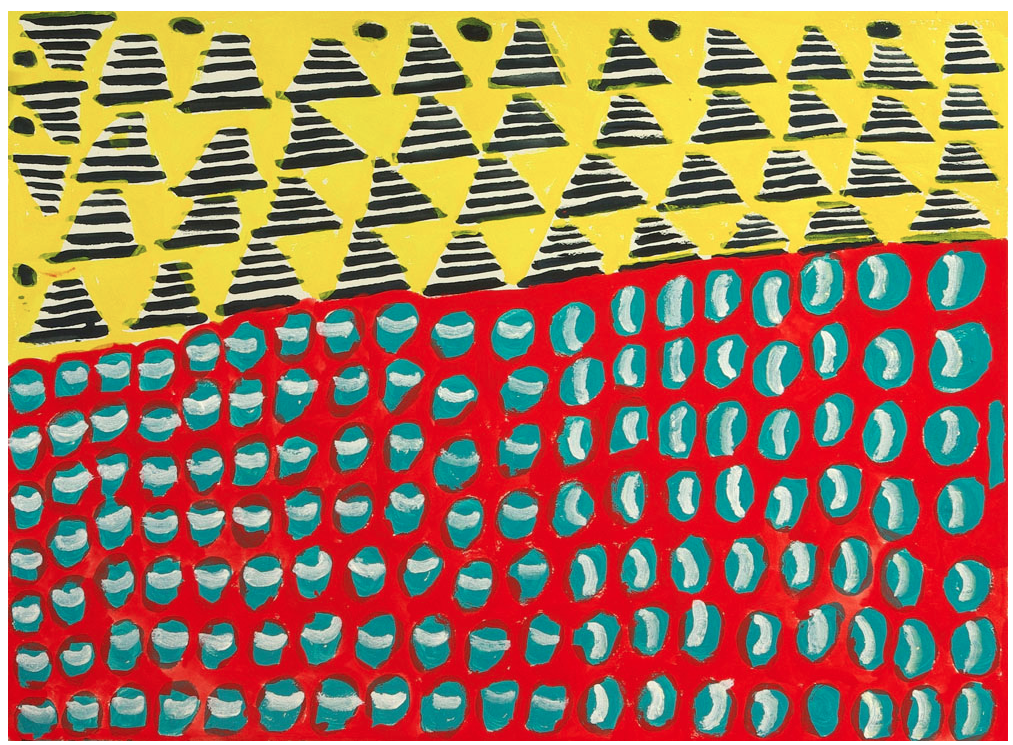
Below: Janangoo Butcher Cherel. Walibirri.
Below: Janangoo Butcher Cherel. Girndi
Below: Janangoo Butcher Cherel. Untitled 2007
Below : Janangoo Butcher Cherel. Dilly Bag & Manyi, 2002
Above: Janangoo Butcher Cherel. Snakeskin 1989.
Below :Janangoo Butcher Cherel. Untitled 1997
Below : Janangoo Butcher Cherel. Tharloo 2005.
Below: Janangoo Butcher Cherel. Untitled 1995.
And last of all, from PAMM, a video that explains the background of aboriginal Australian desert painting.
Enjoy!



